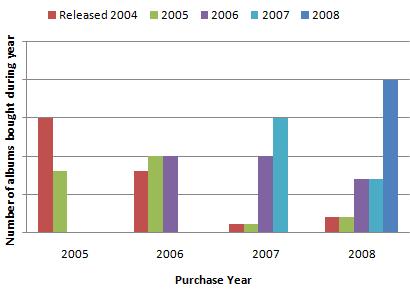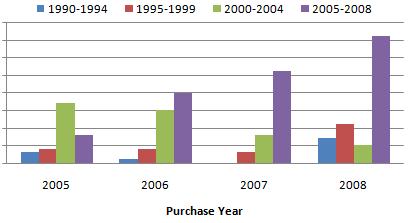
I never bought CD singles for the reasons I think the record companies wanted me to. I bought CD singles for the b-sides.
In the vast majority of cases the singles in my collection are for songs that are on albums that also have.
Also, well over half of the singles in my collection were bought years after they were released. Once I decided I liked a band (Regurgitator, Powderfinger, The Sharp, The Whitlams, Faith No More, Supergroove) I went out of my way to get all of their past singles to get all of their b-sides.
The trend in this graph is toward zero. The bands I liked in the 90s either stopped releasing singles, or I stopped liking them. Very rarely I'll pick up the single for a song I really like hoping for a cool remix, but I'm always disappointed, to the point that I stopped wasting my time.
The spike around 2001-2004 is largely due to the extra singles/EPs bought from bands my band played with, and the last splurge of single buying for The Whitlams, Regurgitator and Powderfinger before I gave up on Timmy and PF and Regurgitator stopped releasing singles.
The standard price of a single these days is about $3-$4. At the height of the single's popularity, singles were about $7 with some being on special for $5. Not long after (late 90s) singles shot up to $9 each, and they never recovered. By the time they decided to get cheap, iTunes had killed them.
Only last week I thought about getting a single for the first time in ages. Metallica's "All Nightmare Long" has been released, and Metallica in their wisdom has again released it with live b-sides. Why live b-sides? They have a website where you can buy whole concerts for very cheap? It's crazy? Where are the cool covers? The demos? The unreleased tracks? Have they forgotten what the b-side is for? Yes.
One of the singles had a documentary about the "All Nightmare Long" video. I would have bought that, except it was $32.
To prove a point I was never actually trying to make, the graph below is a version of the one above only with EPs filtered out, and with only totals for singles where I don't have the album.

The last four years has seen me buy no singles for albums I didn't already have, and even then (as seen above) the numbers are almost zero.
I have officially given up on them... as has JB HiFi.
The singles section is now barely a metre wide.
The data from 2005 to now is fairly solid though. It isn't and exact purchase date, but it's close enough.
The following graph shows the number of albums bought each year between 2005 and 2008, each year's total grouped by the release year of the albums bought.
Number of albums bought for each year 2005 to 2008
... grouped by year album released
In 2005 we bought more 2004 albums than 2005 albums. In 2006 it's fairly consistant across 2004-2006. 2007 saw more 2007 albums than 2006 and almost no 2004-2005, while last year we bought far more new releases than previous year releases.
It shows a general trend toward buying mostly new release music, but also a trend toward buying more music. Even though the 2008 2006 released purchases looks low, it's not much below the 2005 release purchases.
Why the trend toward mostly new music? If we're deliberately buying more music each year, we're less likely this year to buy music we want that was released last year, because we already bought it last year.
We are still buying catalog albums though. This has been helped along by recent mass sales with catalog albums being sold very cheap ($10).
The following graph is much like the above, only each column shows total albums bought for the year sorted by half-decade instead of by single year.
The trends are far clearer in this graph, certainly for this decade. Each year we buy fewer albums from the start of the decade and more from the end.
By "backfill" I mean that each time I go shopping for a CD, not only am I looking at newly released albums, I'm also looking at back catalog. When I buy a CD I might buy a new one, or catalog one.
Over the years, I'd expect to see a graph of albums sorted by year to grow not only in the new years, but also in the historic year totals too... assuming I liked buying catalog music.
I managed to find an old spreadsheet version of my CD collection and used that to get some album totals as at October 2000. The CD database I currently have started in 2003 so I have a total for then, and a total for now.
Total albums in our collection, sorted by release year
Totals as at 2000, end 2003 and start 2009

This graph does seem to generally support my theory, but I'm surprised that in the last four years the number of albums I have for each release year is about the same.
This can be explained I suppose by a deliberate choice during the past four years to not only buy more music, but also to buy more new music as it comes out... but I'm surprised at the constancy.
Blue-spec CD @ Wikipedia.
There is nothing different about a "blu-spec CD" when compared to a normal CD. Your clue here is that it will play on a normal CD player.
The difference is in the manufacturing. Blu-spec CDs are created using a blue laser instead of a red laser. This means the pits can be and are more defined and less prone to manufacturing errors.
This would be fine, except CDs aren't prone to manufacturing errors. When was the last time you bought a CD off the shelf that had a skip in it and that skip was caused by the physical CD itself? I can think on only one example (my copy of "Queen Rocks" which I suspect is a cheap knock-off version).
If you rip one of these blu-spec CDs and rip the same non-blu-spec CD with a decent CD ripper, they'll be identical.
End of discussion.
Except... I did once say that one of the things record companies could do to try to save the CD format would be to put effort into improving the CD manufacturing process so that the CDs were better quality and lasted longer, and then market that fact.
That's exactly what Blu-spec CDs are.
How can I complain about that?
Maybe because this is Sony...

